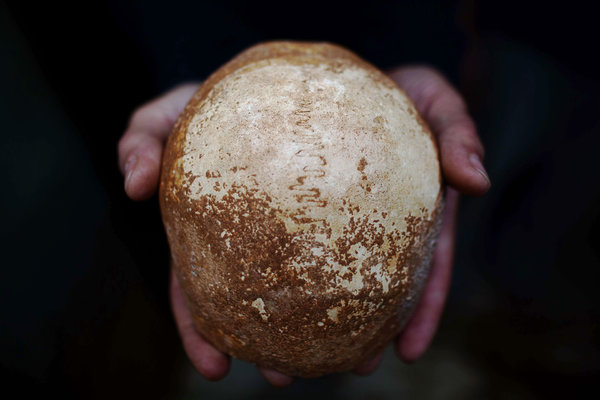Anthropologists exploring a cave in Israel have uncovered a rare 55,000-year-old skull fossil that they say has a story to tell of a reverberating transition in human evolution, at a point when and where some early humans were moving out of Africa and apparently interbreeding with Neanderthals.
古人类学家在以色列探索一座洞穴时发现了一枚5.5万年前的头骨化石,他们认为,这只头骨揭示了人类进化史上一次意义深远的转变。那是在早期人类离开非洲的时候,并且在大迁徙中可能与尼安德特人发生了混血。
The story is of when the Levant was a corridor for anatomically modern humans who were expanding out of Africa and then across Eurasia, replacing all other forms of early human-related species. Given the scarcity of human fossils from that time, scholars say, these ancestors of present-day non-African populations had remained largely enigmatic.
当时,黎凡特地带是一条迁徙走廊,解剖学意义上的现代人从这里走出非洲,走向亚欧大陆,取代了其他所有的早期类人物种。学者说,那个年代遗留下来的人类化石很少,因此,今天非洲以外人类的祖先的情况仍然是个谜。

From the new fossil find, which could be closely related to the first modern humans to colonize Stone Age Europe, it appears that these people already had physical traits a bit different from the Africans they were leaving behind and many other human inhabitants along the corridor.
最近发现的这具化石可能与石器时代移民欧洲的第一批人类关系很近,从化石来看,这群人已经具备了一些特征,与当时留在非洲大陆的人类、以及黎凡特走廊沿线其他人类颇不相同。
Could this support recent genetic evidence that modern Homo sapiens and their Neanderthal cousins interbred, perhaps in the Middle East and most likely between 65,000 and 47,000 years ago? The discovery team urged caution on the interbreeding issue, but noted anatomical features of the cranium suggesting that some human-Neanderthal mixture had presumably occurred before any encounters in Europe and Asia.
近来有基因证据表明,现代智人可能在中东地区与他们的近亲尼安德特人交配,时间大约是6.5万到4.7万年间。这具化石是否支持了这种基因证据?发掘小组的科学家强调在交配假说的问题上需要慎重,但指出,头盖骨的解剖学特征表明,一些智人与尼安德特人混合的迹象可能在这两种人在欧洲和亚洲相遇前,就已经出现了。
The discovery in Manot Cave in western Galilee, made in 2008 and subjected to years of rigorous analysis, was reported on Wednesday in the journal Nature by an international team of researchers led by Israel Hershkovitz of Tel Aviv University. They said this was “the first fossil evidence from the critical period when genetic and archaeological models predict that African modern humans successfully migrated out of Africa and colonized Eurasia.”
在加利利西部马诺特洞穴(Manot Cave)发现的化石是2008年出土的,经过了多年严谨的分析。研究结果由一个多国科学家组成的科研小组于周三发表在《自然》杂志上,他们的领队是特拉维夫大学的伊斯拉埃尔·赫什科维茨(Israel Hershkovitz)。他们说,这是“来自一个关键历史时期的第一份化石证据,基因和考古模型已经预言,非洲现代人类就是在那个时期成功走出非洲,在欧亚大陆定居的”。
The researchers further concluded that the Manot specimen “provides important clues about the morphology of modern humans in close chronological proximity to a probable interbreeding event with Neanderthals.” They also noted that the shape of the cranium established this as a fully modern human at a time when warmer and wetter conditions were favorable for human migration out of Africa.
研究者还进一步得出结论,认为马诺特标本“为现代人类在与尼安德特人发生可能的交配活动前后的形态学特征提供了重要线索”。他们又说,这枚头盖骨经证明属于一个完全意义上的现代人;当时相对更温暖湿润的气候有利于人类走出非洲。
In other words, Dr. Hershkovitz said in an interview, the Manot cranium “is the missing connection between African and European populations.”
换言之,马诺特头盖骨“是非洲人类和欧洲人类之间缺失的中间环节”,赫什科维茨接受采访时说。
Scientists not involved with the research team praised the “fascinating new fossil” and the cautious interpretation of its broader implications in understanding the early migrations into Eurasia. “This fossil fits previous predictions,” said Eric Delson, a paleoanthropologist at Lehman College of the City University of New York, “which is a nice rarity in our field.”
未参与这个研究项目的科学家赞扬了这块“奇妙的新化石”的发现,以及关于它对理解人类进入亚欧大陆过程的意义的谨慎解读。“这块化石与此前的预言吻合,这在我们这个学科领域,是少有的,”纽约市立大学李曼学院的古人类学家埃里克·戴尔森(Eric Delson)说。
Dr. Delson, also a researcher at the American Museum of Natural History, added, “As always, we want more fossils to document variations in and details about this presumed fossil population.”
戴尔森还是美国自然历史博物馆的研究员,他补充说:“我们总是希望获得更多化石样本,以便记录这个可能存在的群体的变异和有关他们的详细情况。”
In an email, Dr. Delson praised the journal authors “for hitting the mark with their analyses and interpretations, reaching all the possible conclusions one could think of: The partial skull combines a basically modern human form with a few features also found in Neanderthals.” In addition, he pointed out, the analysis “supports the similarity of its shapes” to those of modern Africans and early modern humans from Europe, such as the Cro-Magnons.
戴尔森在电子邮件中赞扬论文作者的“分析和解读十分恰当,得出了我们能想像得到的所有结论:这块头骨既有现代人类的基本特征,也有一些尼安德特人的特征”。此外,他也指出,他们的分析“可以支持头骨形状近似”现代非洲人和早期欧洲人——比如克罗马侬人——的事实。
The partial skull, designated Manot 1, is of a fairly small adult individual, its sex undetermined. The distinctive bunlike shape at the base of the skull resembles modern African and European skulls but differs from other anatomically modern humans from the Levant, and is thus a strong clue that these were among the first humans to settle Europe, scientists said.
这块头盖骨被命名为马诺特1号,属于一个身材较小的成年人,性别待定。颅骨基部明显的髻状突起接近现代非洲人和欧洲人,但有别于其他在黎凡特地带发现的现代人种,因此强有力地暗示着,这可能是早期进入欧洲的人类。
Dr. Delson agreed that the evidence “makes it possible that this individual is (or is descended from) a ‘hybrid’ between modern humans and Neanderthals, but as the authors note, such a conclusion cannot be reached from a single fossil, especially as hybrids between species of modern primates usually have some genetically related anatomical oddities.”
戴尔森同意,这些证据“可能说明这个人是现代人与尼安德特人的混血(或其后代)。但正如论文作者所说的,不能从一块化石就得出这样的结论,特别是考虑到现代灵长类动物的跨物种混血后代往往都存在某些遗传上的解剖学异常”。
One concern is that the fossil skull is fairly small, with a somewhat lower braincase capacity than in modern humans. With only one specimen, it is hard to know whether this is normal for the general population, scientists said. And Dr. Delson said it would be interesting to test for DNA in the skull to support its possible hybrid status in a time of overlapping modern human-Neanderthal populations when early humans were making their way, as he phrased it, to “that small zoological backwater of Eurasia known as Europe.”
顾虑之一,是这件颅骨化石相对较小,脑容量比现代人小。因为只有一件化石标本,科学家很难判断,这是不是这个群体的普遍特征。戴尔森说,如果能检测头骨的DNA,从而证实这的确是现代人与尼安德特人共存时代的一个混血人种,那将是很诱人的。他说,“今天所谓的欧洲,是亚欧大陆物种进化的一个小支流”。
Excavations at Manot Cave are expected to continue through at least 2020, searching deeper for more fossils and artifacts from the migrating people. Israel, Dr. Hershkovitz said, “is like a Swiss cheese, lots of caves everywhere.”
在马诺特洞穴的挖掘预计将至少持续到2020年,更加深入地寻找更多迁徙人类留下来的化石和器物。赫什科维茨说,以色列就像“一块瑞士奶酪,到处都是窟窿”。
Several caves in the vicinity of Manot were occupied for long times by Neanderthals between 65,000 and 50,000 years ago. In this respect, Dr. Hershkovitz said, Manot is an excellent place to search for possible hybrids, but they may be difficult to recognize from surface features. “Only DNA study will solve the problem,” he said.
马诺特洞穴附近的一些洞穴,在6.5到5万年前,长期被尼安德特人栖居。考虑到这一点,赫什科维茨说,马诺特是寻找混血人种的理想场所,但从表面特征上,可能很难识别。“只有DNA研究能给我们答案,”他说。













